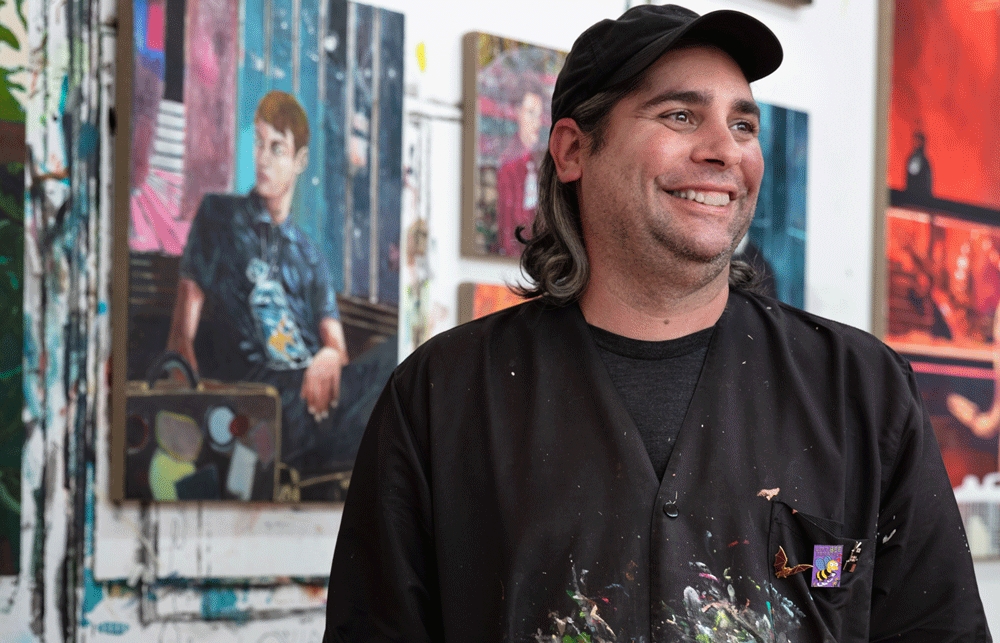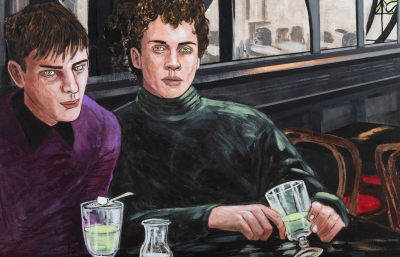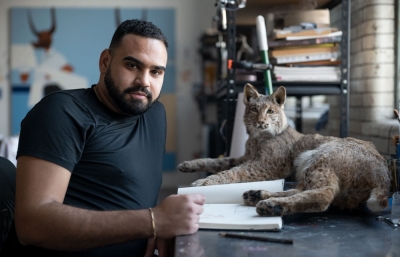Hernan Bas
A Certain Southern Gothic
Interview by Evan Pricco // Portrait by Siliva Ros
There is a subtle inculcation from an early age that a penchant for the weird does not predispose a successful career. Even though the creatives who sport a quirky odd streak are warily admired, no one asks the school guidance counselor about how a love for The X-Files might result in a scholarship in paranormal studies. I’ve read countless interviews with the Miami-born Hernan Bas, many citing the inspiration behind his work, where there seems to be an alignment with the alluringly decadent and mysterious works of literature by great Gothic writers of the past like Mary Shelley, Poe, or Wilde. That, coupled with his move to north-central Florida at a young age, results in a steeping in Southern Gothic tradition that oozes from each painting. His characters have grown up over the two decades Bas has been in the limelight, with hostile humor, sadness, growth, and isolation riddling each painting. Either Bas is the enigma or his signature moments are, and that he has dedicated his craft to often misunderstood or underappreciated moments of history makes him a unique and influential voice in contemporary figurative painting.
I’ve always wanted to speak to Hernan Bas because I hoped to excavate the humor in his work, which provides plenty to unpack. But there is tragedy, too. After losing his mother earlier in 2020 to Covid, he made a remarkable body of work, Creature Comforts, that was on display at Perrotin in Paris through early 2021. We talked about the genesis of that series, how nature was reflected in the paintings, and how a sustained desire to uncover the mysteries of the world is one of life’s truly important journeys.

Evan Pricco: You are based both in Detroit and Miami, but as we speak, you're in Florida now?
Hernan Bas: I'm in Miami now. I spend more time in Miami, these days, and I've been back here since March 2020 and I haven't been back to Detroit or anywhere.
Was it just a coincidence, or did you think, "If there's going to be something that’s going to happen to all of us, Miami's a better place for me to be.” You have a lot of shows, so I assume spending time in the studio is mostly what you do anyway?
I think it's the latter for me. Social distancing is not a stretch for me. That's my day-to-day life, regardless, to some extent. I basically go from home to the studio every single day, pretty much. And I don't have any studio assistants, so that was never an issue either. I was in Italy right as the whole world was shifting, so when I got back to Miami and saw what happened to Venice and Milan, I'm not doing anything. I'm not going anywhere.
I did lose my mom to Covid, which was terrible. I mean, during the lockdown, Miami has not really been super responsible, let's put it that way. To this day, it's mind-numbing how people just don't understand what social distancing means. And that was, I don’t know, it sucked, but besides that, it's been relatively peaceful.
Oh my god, I’m sorry to hear that. We’ve heard so much about death over the last 12 months as such an abstract statistic, but when it’s close and real emotions are involved, that’s incomprehensible. I was going to ask you how Miami was in the absence of the fairs, but also growing up there. Had Miami been more of an art capital 25 years ago, would it have changed you or your approach?
I probably would have run to New York faster. No matter what, there is still that Miami flavor that everything's a spectacle, you know? When I was younger, the only art you could see was what is now called the Perez Museum, which was four blocks from my high school. My only understanding of art was going to the public library by myself, or with my friends, and just poring over all the books they have.
There was no gallery district. Technically, the gallery that I worked with in Miami all these years was way down south, where nobody goes now. You wouldn't find anyone coming for Basel. The whole creation of Wynwood and the art district was also somewhat of a ploy for real estate as far as I was concerned. Early on, these developers would give you the free space for studios, and then, coincidentally, a few years later, the neighborhood's up and coming. It's a classic case of gentrification. So, I tried to get away from that as quickly as possible. I want to do my own thing. I don't want to be beholden to whatever this is. I'm kind of ambivalent about the whole Miami scene. One of the reasons I went to Detroit was because I wanted to jump out of this.

It’s funny, I was driving around Detroit with some friends, maybe five years ago and it was minus three degrees and we are listening to Kraftwerk in a snowstorm. We drove past your studio and someone said, “That is where Hernan Bas is based,” and that made sense to me. As an outsider, Miami didn’t make sense to this pretty isolated aesthetic. And yet, in recent years, I definitely see the Southern Gothic, swampy vibe so strongly.
The Southern Gothic world of, you know… Detroit, basically [laughs]. My work has nothing to do with urban decay. What I was intrigued by was the fact was there were all these “haunted” houses. That's what I found more interesting than urban-type decay. I was only there for maybe one year, full-time, when I finally started being okay with painting tropical-ness. Being away from it, you miss it. I first started making those pink flamingo works when I went to Detroit. If you live in Miami, you can’t paint flamingos, but in Detroit you can, they won't make fun of me [laughs]. So, it was a weird mental flip that happened.
Do you feel a kinship with that rich history of Southern Gothic aesthetics? Is it weird that I don't consider Florida the South and think of it as its own completely unique place? I’m thinking of Faulkner, Mississippi, hauntings and murders on the bayou sort of thing.
I was born in Miami but right afterwards, my parents moved to the middle-of-nowhere in northern Florida, and I spent seven years of my life there. That's where I think that sort of spirit of the South imbued itself in me, because we'd take trips, weekend trips with all my family, and we would go to Weeki Wachee Springs. That’s sort of the side of Florida I think of when I try to paint anything in my head that is emblematic. I've never done art deco, bikini-clad ladies.
When did these characters start formulating in your head?
Good question. I don't really know. I'm trying to think back to the early work. It seems so far away now, 20 years almost. I think it was always the love of literature and just characters, in general. I was more of an avid reader of fiction when I was younger than I am now. But not just fiction; mythology and the tie-in to the paranormal. I've always sort of thought of the work as being... at the end of the day, when I'm off the planet, it will be like an encyclopedia of the strange course of my life.
But the actual character of the figure? I don't like to think of it as portraiture at all. I've been quoted as describing it as the state of where you don't really know what or who you are. Or back to literature, a Catcher in the Rye type of thing. It's all there. And I've always been drawn to that sort of in-between. I mean, no one wants to read a book where the character is so easily understood and defined.

Absolutely, what I have always been drawn to both in life and literature, are people who are always in a constant identity limbo or not fully-formed in some perfect definition. I want a little mess. I was thinking about this, that in your research later on in life, are there painters that you didn't realize were maybe into the same things that intrigued you? Maybe museums omitted that part of their interest in describing them, but I’m going to assume that you are not alone in being interested in hauntings and the paranormal.
Oh, I haven't thought of that in a while, but I think a good example would be something I recently read about Edward Hopper. The reason those paintings are creepy is that the main figures tend to be looking off, I guess you could call it off-stage, or off-camera, but always looking at something not in the frame. That sort of weirdness I've really become drawn to in his works recently. Another person I came to late in the game was Charles Burchfield. He's not someone I became exposed to until maybe 10 years ago. The gloomy Burchfield stuff that people talk about, they talk about Song of Spring and the butterfly work. But he was a dark man.
Even within my own work, I've noticed particular trends where people are drawn to certain things even more. For example, I had two paintings that my gallerist here in Miami had to pick from for his little Miami art week exhibition.
Is that the one with the waves? Such a beautiful painting.
Yeah. So, that's the one he picked. But the one he opted out on, which is in a similar vein, has got blood in it. That automatically burns off a considerable amount of collectors. It's got a similar kind of thing going on, but the hammerhead shark has blood on its mouth. A little Hemingway never hurt anybody.
Creature Comforts, your recent body of work on view at Perrotin in Paris as we speak, is such a beautiful show, and there are just so many stunning works. I was thinking the characters feel a little bit more in turmoil, and I didn't realize that your mother had passed. Maybe that is part of it? But also, with such an inundation of bad news this year, it seems like each character is put in this situation where there's a lingering evil, or lingering ominous forces.
I think with the characters generally, they're isolated. But I think something about the idea of being forcibly isolated, maybe? Taking that character that was relatively normal, but in this stage of life, he has to become manic about something. A lot of my characters had that already in them, but I feel like it got more exaggerated.

There’s one painting in particular that I absolutely love, the vampire at the bar. It’s just loaded with so much detail and just a bit of a scary one.
The vampires, yeah, that was a fun one. I liked the idea of… what would you call it, providing comfort to creatures who don't know what's going on. After leaving Venice, just after the pandemic, I read this story about how the canals are clearing, turning crystal clear. True or not, this is amazing. Nature conquers all. So I think that was how the sort of creatures, literal animal creatures, came into play for me. And just being in Miami, too, just the back of my commercial building at the studio, I remember seeing birds that are not often seen. I was like, "What is happening?" So there was a bit of a weird return to nature that was happening in the paintings that I kind of got fascinated with. But, with the vampires, sometimes it's just for the sake of humor that I do things.
Do you think people miss the humor in your work, then?
I think that people want to take things so seriously in general, and it's the grand tradition of painting. They are just grand paintings. People will automatically associate the size of the work to something being historical.
I like making these epic paintings of the dull moments, in a sense. Two or three years ago, I made one of the largest paintings I've ever done. It was based on the Andy Warhol estate. He was a massive hoarder, which we didn't know until he died. And so, the estate set these people up to catalog the apartment, and they found out how insane he was, basically. Jewels tucked under beds. All kinds of stuff. And so, the painting is this giant spread of all of Warhol's stuff with a cataloger sitting in the middle of all of it. Every single item in the painting was an item from Warhol's estate. I did a lot of research for that. I just loved the idea of this kind of painting, but it's really just this poor guy sitting with all of Warhol's estate all around him. The point of that work, Sorting Out Andy, was that if I make a history painting, I want it to be a moment that's been not just overlooked, but would never be discussed as being important. But to me, that's a really important moment in art history. That's what drew me to that whole scene. Also, just for fun, the idea of someone petting Warhol's wig…
And, half the time, you're working away at this painting for, sometimes, months at a time. You kind of have to laugh for yourself, for your own sake, for your own sanity.

Also, the fact that you don't have assistants in the studio with you might result in kind of having your own internal jokes going on.
Sitting alone in the studio and sometimes I think to myself, "I'm so funny.” [laughs]
Well, do you think the paranormal is often funny?
I think it has potential to be completely ridiculous.
Right, that’s a far better description.
I mean, when you think of it, I don't know if ridiculous is the right word. Absurd, I guess, is the best descriptor. I watch all of those ghost hunter shows and it's always a bunch of nonsense. Nothing is ever really captured on film, or anything. But there is a lot of weird humor. The one thing I'm not super keen on, but think is hysterical, is to watch some of these people on TV who claim to be psychics. To me, it's just a laugh.
I think the idea of a coincidence is misunderstood in a lot of our society.
It's definitely a thing. Even UFO stuff; I love seeing drawings kids make of UFOs, and stuff like that. I mean, that's a whole other genre. Vampires are hysterical.
Who originally stoked this paranormal flame in you?
My older brother and older sister were the ones that got me into the paranormal when I was younger, that good weird stuff. When I was a kid, they would bring back books from the library about vampires and ghosts, so I got a lot of my early goth from those two. My brother is still very much entrenched in that world in New Orleans, and my sister, who lives in California, still goes bigfoot hunting. That's half of my family: always hanging onto the weirdness.
What I love about that is it’s more about the mystery, as opposed to the actual end result of finding bigfoot. I went to Loch Ness in Scotland with my parents maybe 20 years ago. We weren’t going there to look for the monster, but the actual journey was the fun part. This idea that life has to have more, that the universe can’t just be some simple thing. We need those mysteries. That's kind of what you seem to be tapping into. Getting yourself to a place, in order to believe.
I did a painting of a fictionalized portrait of the guy who has the Guinness World Record for most time spent watching Loch Ness. He lives in a van down by the river, literally. He's been looking for, I think, 42 years, or something like that. And he makes these little Loch Ness sculptures and he sells them. That's how he makes a living to eat. To me, it's not about proving that the Loch Ness monster exists but what it could be. Who knows? They're hopeful. People always think that the characters are sad, but I think they're hopeful. I love the idea of a character who would be willing, for the rest of their life, to look for something that doesn't exist.






